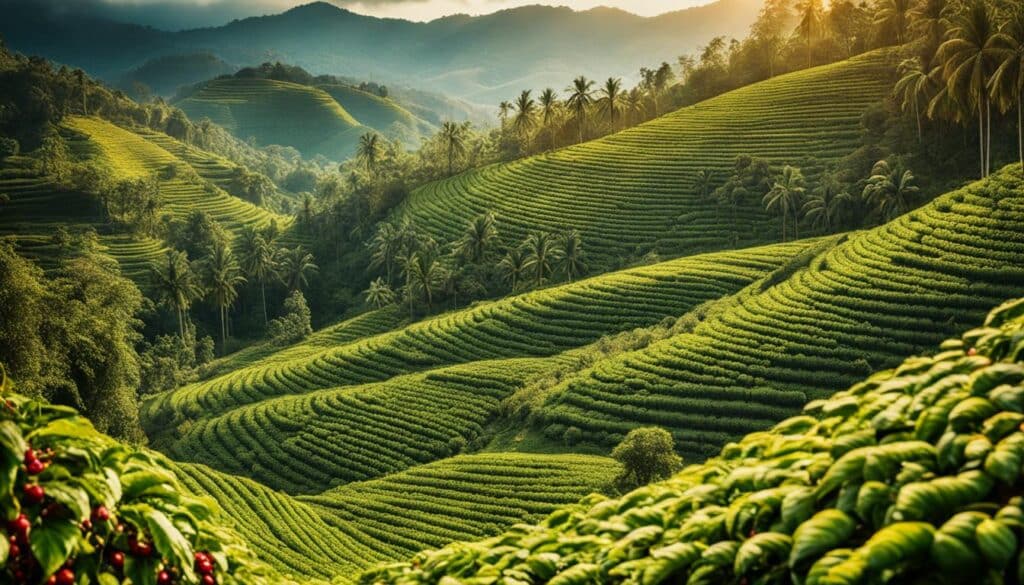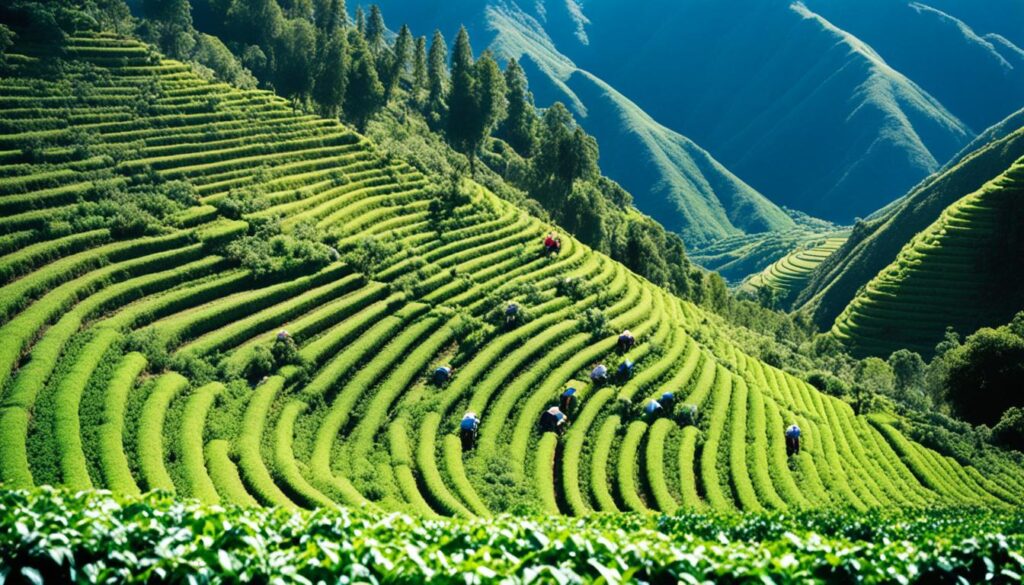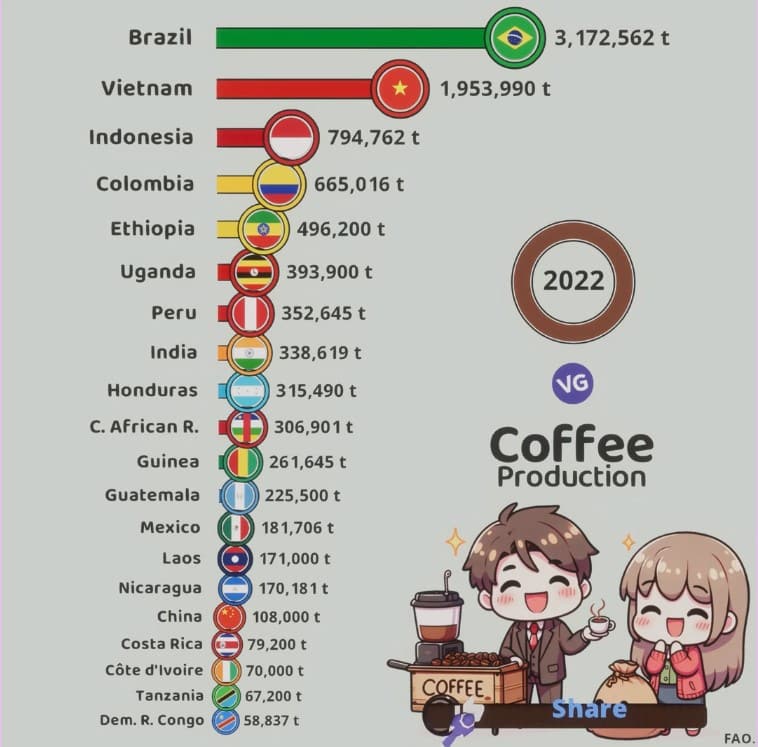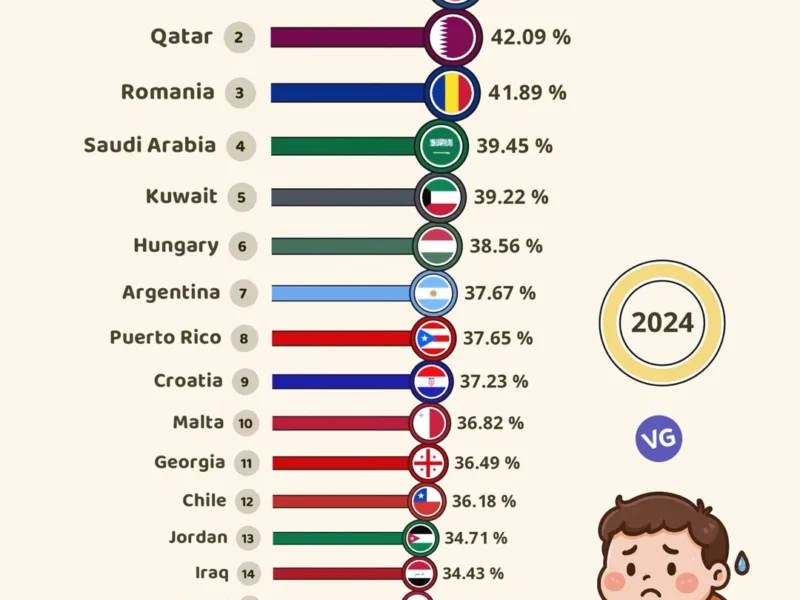In 2022, the world produced a massive 10.8 million tonnes of coffee. Brazil led the way, making 29% of the world’s coffee1. From Brazil’s green hills to Vietnam’s highlands and Indonesia’s varied lands, these countries are the biggest coffee producers. They grow the coffee that people all over the world love1.
World Largest Producers of Coffee 2022
| Country | Flag | Production (tonnes) |
|---|---|---|
| Brazil | 🇧🇷 | 3,172,562 |
| Vietnam | 🇻🇳 | 1,953,990 |
| Indonesia | 🇮🇩 | 794,762 |
| Colombia | 🇨🇴 | 665,016 |
| Ethiopia | 🇪🇹 | 496,200 |
| Uganda | 🇺🇬 | 393,900 |
| Peru | 🇵🇪 | 352,645 |
| India | 🇮🇳 | 338,619 |
| Honduras | 🇭🇳 | 315,490 |
| C. African R. | 🇨🇫 | 306,901 |
| Guinea | 🇬🇳 | 261,645 |
| Guatemala | 🇬🇹 | 225,500 |
| Mexico | 🇲🇽 | 181,706 |
| Laos | 🇱🇦 | 171,000 |
| Nicaragua | 🇳🇮 | 170,181 |
| China | 🇨🇳 | 108,000 |
| Costa Rica | 🇨🇷 | 79,200 |
| Côte d’Ivoire | 🇨🇮 | 70,000 |
| Tanzania | 🇹🇿 | 67,200 |
| Dem. R. Congo | 🇨🇩 | 58,837 |
The coffee industry is always changing, making the competition among top producers tough. Each country is working hard to improve its coffee production, quality, and exports. This article tells the exciting stories of these coffee giants. It looks at what makes them leaders in the global coffee market12.
Key Takeaways
- Brazil is the world’s largest coffee producer, accounting for 29% of global output in 2022.
- Vietnam and Indonesia follow closely as the second and third largest producers, respectively.
- The world’s total green coffee production in 2022 was a staggering 10.8 million tonnes.
- Brazil, Vietnam, and Colombia are the top three coffee exporting countries.
- The coffee industry is a critical global commodity, with intense competition among the top producing nations.
Introduction
Coffee Production (2022)
Source: VG (2022)
.
.
Coffee is a key player in the economies of many developing countries3. It’s the second most traded item globally, after oil3. About 50 countries export coffee beans, making it a big deal for millions of people’s lives worldwide3.
Importance of Coffee as a Global Commodity
Coffee is a big deal for many countries’ GDPs3. Countries like Brazil, Vietnam, Colombia, and others have the perfect climate for growing top-notch coffee beans3. They produce both Arabica and Robusta types.
Overview of Top Coffee-Producing Countries
Brazil leads as the biggest coffee producer, making 2,680,515 metric tons a year3. Vietnam is close behind, producing about 1,542,398 metric tons3. Colombia also does well, with 754,376 metric tons3.
Indonesia is fourth, making over 668,677 metric tons of coffee3. Honduras follows, with 475,042 metric tons3. Ethiopia, where coffee started, produces 471,247 metric tons3. Peru adds 346,466 metric tons to the total3.
India, Guatemala, and Uganda also make the list, with 234,000, 245,441, and 209,325 metric tons, respectively3.
These countries greatly influence the global coffee scene4. They offer a wide range of coffee types, unique tastes, and sustainable farming methods4.
“Coffee is the second most traded commodity in the world, second only to oil.”
Brazil: The Coffee Powerhouse
Brazil’s coffee industry is a giant, with a history over 150 years old5. It leads the world in coffee production, making up about a third of global output5. With over 300,000 farms, from small family farms to big industrial ones, Brazil is famous for both commercial and specialty coffees5.
Climate and Soil Conditions for Coffee Cultivation
Brazil’s climate is perfect for coffee, with lots of rain, moderate temperatures, and rich soil5. The main coffee areas are Minas Gerais, São Paulo, Espírito Santo, Bahia, and Paraná5. Espírito Santo is the top producer of Robusta beans5. The ABIC makes sure coffee quality stays high in Brazil5.
Varieties of Coffee Beans Grown
Brazil grows both Arabica and Robusta coffee, with Arabica being the main type5. The main Arabica types are Bourbon, Mundo Novo, Catuaí, and Icatu, each with unique tastes5. The country also has special coffee areas like Alta Mogiana and Campo das Vertentes, known for their unique flavors6.
Brazil is also focusing on sustainable and traceable coffee6. Groups like the BSCA support sustainable farming and specialty coffee5.
Brazil is the top coffee producer in the world, thanks to its great history, climate, and variety of coffees7. The industry is always changing, meeting new market needs and focusing on sustainability. This ensures a strong future for coffee lovers7.
Vietnam: The Rising Star
Vietnam has become a big name in the coffee world, ranking as the second-largest producer globally8. It made over 29 million 60-kilogram coffee bags in 20228. This growth started after economic reforms in 1986, letting private companies join the coffee market and grow.
The French brought coffee to Vietnam in the 19th century, and it quickly took off9. Vietnam is famous for its Robusta coffee, loved for its unique taste8. Now, there’s also a big interest in specialty Arabica coffee, especially in Lam Dong, Son La, and the central coast9.
The Vietnamese coffee industry has grown fast, making Vietnam a top coffee producer8. With its many coffee-growing areas, skilled farmers, and focus on quality, Vietnam is set to keep growing in the coffee world.
Colombia: The Land of Arabica
Colombia is known as the third-largest coffee producer worldwide, making up 7% of global production10. Its coffee is a big part of its culture and traditions. The National Federation of Coffee Growers of Colombia supports over 500,000 producers and funds coffee research11.
Colombia’s Coffee Culture and Traditions
Coffee is very important in Colombian life. The Café de Colombia organization speaks for the country’s coffee trade and gives back to coffee-growing areas10. In 2011, UNESCO named the “Coffee Cultural Landscape” of Colombia a World Heritage site. This shows the strong bond between people, the land, and coffee11.
Unique Flavor Profiles of Colombian Coffee
Colombian Arabica coffee beans grow at high altitudes, making them medium-bodied with a nutty smell and a touch of citrus10. All of Colombia’s coffee is Arabica, known for its quality, lightness, sweetness, and mild acidity10. About 500,000 families in Colombia work in coffee, growing high-quality beans on their farms10.
Colombia sends its famous coffee beans to countries like the United States, Germany, France, Japan, and Italy11. The European Union gave Colombian coffee a special status in 200711. Colombia produces about 11.5 million bags of coffee each year, making it the third-largest producer after Brazil and Vietnam11.
“Colombia is the largest and most influential producer of mild Arabica coffee worldwide.”10
world largest producers of coffee
The world’s coffee industry is led by a few countries, making over 90% of the coffee12. Brazil is the top producer, making 29% of the world’s coffee13. Colombia is second, followed by Mexico, Guatemala, and Costa Rica, each with their own unique coffee types12.
New countries are joining the coffee industry, like Vietnam, which is quickly becoming a major producer12. Indonesia is also a big player, known for its high-quality coffee from islands like Sumatra, Java, and Sulawesi12.
Most top coffee producers are in the tropics, where the climate is perfect for coffee13. But coffee is grown in over 50 countries, each adding its own flavor to the global market13.
| Country | Production (in thousand 60-kg bags) | Percentage of Global Production |
|---|---|---|
| Brazil | 69,00014 | 39.4%13 |
| Vietnam | 31,60012 | 18.6%13 |
| Colombia | 14,30014 | 8.4%13 |
| Indonesia | 10,90012 | 6.4%13 |
| Ethiopia | 7,50012 | 4.4%13 |
The coffee world is always changing, with each country adding its own touch to the global industry13. As demand for quality coffee grows, these leading producers will be key in satisfying our love for the perfect cup13.
Indonesia: A Diverse Coffee Landscape
Indonesia is a big name in the coffee world, being the fourth-largest producer globally and second in Asia15. Coffee is very important for Indonesia’s economy, ranking as the third-most crucial commodity15. Its coffee history goes back to the late 1600s when the Dutch brought coffee to the region16. Now, Indonesia is known for its diverse coffee, offering many famous types.
The History of Coffee in Indonesia
The story of coffee in Indonesia started in the late 17th century with the Dutch introducing coffee to Java16. Over time, coffee spread across the islands, with the main coffee areas being Aceh, Sumatra, Java, Bali, and Sulawesi16. Today, Indonesia sends 5% of the world’s coffee exports17, with almost all of it coming from small farms17.
Renowned Indonesian Coffee Varieties
Indonesia is famous for its wide range of coffee types, each with its own taste and way of growing16. Top Indonesian coffees include Kopi Luwak, Toraja Coffee, Mandheling Coffee, Gayo Coffee, and Java Coffee16. These coffees are loved for their special traits, like Kopi Luwak’s unique making process and Toraja Coffee’s strong taste16.
Indonesia’s coffee scene is also known for its lively culture and special brewing ways, like Tubruk, Siphon, and Giling Basah16. With about 1.24 million hectares of coffee farms17, 25% for Arabica17, and 1.77 million jobs in the coffee industry17, Indonesia is a key player in the global coffee world.

| Coffee Region | Unique Characteristics |
|---|---|
| Aceh | Known for its high-quality Arabica coffee beans16 |
| Sumatra | Offers full-bodied, earthy, and low-acidic coffee flavors16 |
| Java | Recognized for its rich, full-bodied flavor grown in volcanic soil16 |
| Bali | Cultivates coffee with hints of cocoa and spices in nutrient-rich volcanic soil16 |
| Sulawesi | Presents distinct flavor and low acidity in its coffee16 |
“Indonesia’s unique coffee varieties and vibrant culture make it a highly sought-after origin for coffee enthusiasts around the world.”
Honduras: Climbing the Coffee Ranks
Honduras is now the fifth-largest coffee producer in the world, adding 4.4% to global production18. It was once overlooked due to poor infrastructure, but now, its coffee is known for quality and unique flavors18.
Most of Honduras’ coffee comes from small farms on mountains, between 1,400 and 1,700 meters high18. These farms create a variety of flavors, like hazelnut and vanilla. In 2021, coffee exports reached $1.3 billion, making up 26.2% of Honduras’ exports18.
The Honduras coffee industry now makes up 30% of the country’s agricultural GDP18. Over 100,000 small farmers benefit from this growth18. Coffee exports brought in a 47.8% trade surplus in 202118.
Honduras is in the top 10 coffee producers worldwide18. Its coffee goes to over 55 countries18. The increase in global demand for coffee drives Honduras’ production18.
Subida Coffee Co. is a non-profit that helps youth in the coffee industry18. It gives all profits back to the community19. This shows Honduras’ dedication to sustainable and responsible coffee production.
Ethiopia: The Birthplace of Coffee
Ethiopia is known as the birthplace of coffee, with a deep history and tradition. This has greatly influenced the global coffee industry20. It makes up about 17% of the world’s coffee market20. In 2022, it was the fifth-largest producer, adding 496,200 tonnes to the global supply20. Over 4 million small-scale farmers in Ethiopia grow coffee, with half of it being consumed there20.
The Story of Coffee’s Discovery in Ethiopia
The story of coffee’s start in Ethiopia goes back to the 9th century. A goatherd named Kaldi saw his goats get more energetic after eating the red berries of a special plant21. This discovery led to the start of coffee’s commercial cultivation in the area by the 16th century21.
Unique Ethiopian Coffee Varieties
Ethiopia is home to a variety of unique coffee types, each with its own taste21. These beans are grouped into three main types: Longberry, Shortberry, and Mocha20. Varieties like Sidamo, Genika, Harar, and Kaffa are known for their high quality and unique flavors20. The way the coffee is processed, like the Natural Process and Washed Method, also adds to its distinct taste21.
Most of Ethiopia’s coffee stays in the country20, but the coffee it exports is highly sought after worldwide20. The main markets for Ethiopian coffee are the EU, East Asia, and North America20. Even with the threat of climate change, which could cut yields by up to 70%20, Ethiopia remains a key player in coffee production. It stands as a symbol of the long history of coffee21.
Peru: The Andean Coffee Gem
Peru is a hidden gem in the Andes, known for its top-quality coffee and unique tastes22. In 2019, it was named the “Best Coffee Producing Country in the World” by the Specialty Coffee Association of America22. Peru is the 10th biggest coffee producer and the 5th largest of Arabica coffee22. Over 120,000 farmers grow coffee on the Andes’ slopes22.
Influence of High Altitude on Peruvian Coffee
High-altitude growing is key to Peruvian coffee’s quality23. Most of Peru’s coffee grows above 1,200 meters high, aiming for the best quality23. This high place gives coffee a special taste, with a medium body and a tangy finish22.
Peru’s main coffee areas include Amazonas, Ayacucho, and others, each with its own unique climate23. The high altitude and varied regions create a wide range of coffee flavors23. You can find everything from nutty and chocolatey to citrusy and floral tastes23.
Peruvian coffee is more than just great quality; it’s part of Peru’s coffee culture and cooperative efforts22. The Cenfrocafe Co-op began with 220 farmers and now helps over 2,000 members22. The Peru La Florida Co-op grew from 50 farmers in 1966 to over 1,200 members22.
As coffee lovers look for unique tastes, Peru’s coffee is a standout222324.

India: A Tea and Coffee Powerhouse
India is famous for its tea, but it’s also a big player in coffee production. It’s the eighth-largest coffee producer, making 3.1% of the world’s coffee25. This has made India a unique name in the coffee world.
Robusta vs. Arabica Coffee Production
Over time, India has changed its coffee focus from Arabica to Robusta. Now, Robusta makes up 60% of India’s coffee25. This change is big, showing how the demand for Robusta has grown.
The shift to Robusta is thanks to its hardiness and high demand. The main coffee areas are in Kerala, Tamil Nadu, and Karnataka. These places have the right climate and soil for both Arabica and Robusta25.
India’s “Seven Sister States” also grow coffee, but less. They mainly sell to the local market25.
India’s coffee farms often grow coffee under shade with other fruits and spices. This method is good for the environment and helps protect biodiversity. The Western Ghats are a key area for this kind of farming25.
| Coffee Variety | Production (million bags) | Percentage of Total Production |
|---|---|---|
| Arabica | 94.0 | 55.7% |
| Robusta | 74.2 | 44.3% |
Even with more Robusta, India is still a big name in coffee. Over 70% of its coffee is exported25. Coffee leaf rust has hit the industry hard, making Robusta more popular25.
India is working through these challenges. Its diverse coffee and sustainable farming are getting more attention worldwide. This keeps India strong in both tea and coffee markets26.
Guatemala: The Central American Coffee Contender
Guatemala is a key player in the global coffee scene, despite its small size. It’s known for its high-quality Arabica coffee beans. These beans make up 2.1% of the world’s coffee production27.
Traditional Coffee Growing Regions
Guatemala’s coffee comes from several famous regions, each with its own taste. These include Antigua, Acatenango, Atitlán, Cobán, Huehuetenango, Faijanes, San Marcos, and Nuevo Oriente27. Each region has different heights, soils, and climates, leading to a wide variety of coffee flavors.
You’ll find everything from spicy and smoky to milder tastes with a touch of tang27.
| Coffee Region | Flavor Profile |
|---|---|
| Antigua | Spicier, smokier |
| Acatenango | Moderate acidity, slight tang |
| Atitlán | Bright, aromatic, fruity |
| Cobán | Balanced, complex |
| Huehuetenango | Delicate, floral |
For a long time, coffee has been a source of pride and income for Guatemala. By 1880, coffee made up 90% of its exports27. Today, Guatemala is still a big name in the coffee world. It offers a variety of high-quality Arabica beans that coffee lovers around the globe seek28.
“Guatemalan coffee is known for its distinct flavor profile, with a unique balance of acidity, sweetness, and complexity that sets it apart from other Central American coffee varieties.”
Conclusion
The world’s biggest coffee producers are a mix of countries that make up over 90% of global coffee. Brazil leads with a massive 2,993,780 tonnes of coffee in 2023, making it the top producer29. Vietnam is second, adding 1,845,033 tonnes to the total29. Countries like Indonesia, Colombia, Ethiopia, Honduras, Uganda, Peru, India, and Guatemala also play big roles, each with their own unique coffee styles2930.
These countries are not just big in production. They also bring a lot of variety to the coffee world. From Brazil’s Robusta and Arabica beans to Colombia’s high-quality Arabica and Ethiopia’s coffee roots, the world’s coffee is rich in flavors and traditions30.
As more people around the world drink coffee, these leading countries will be key in meeting that demand. They are using their strengths and sustainable methods to keep the coffee industry alive and diverse. This way, they can keep satisfying the changing tastes of coffee lovers everywhere.
FAQ
What are the top coffee-producing countries in the world?
The top coffee producers are Brazil, Vietnam, Colombia, Indonesia, Honduras, Ethiopia, Peru, India, Guatemala, and Uganda, as per the FAOSTAT of the United Nations.
How much does Brazil contribute to global coffee production?
Brazil leads the world in coffee production, making up 29% of global output.
What are the main coffee varieties grown in Brazil?
Brazil cultivates both Arabica and Robusta coffee. Arabica is the main type, with varieties like Bourbon, Mundo Novo, Catuai, and Icatu.
What is the second-largest coffee producer in the world?
Vietnam is the second-biggest coffee producer, contributing 18% to global output.
What type of coffee does Vietnam primarily produce?
Vietnam mainly produces Robusta coffee. It’s known for its low acidity and bitterness, ideal for blends and instant coffee.
What is Colombia known for in the coffee industry?
Colombia is famous for its high-quality Arabica coffee. It’s known for its aromatic, mild, and fruity flavors.
How much of the global coffee production do the top 10 producers contribute?
The top 10 coffee producers, including Brazil, Vietnam, Colombia, and others, produce over 90% of the world’s coffee.
What is the unique characteristic of coffee production in Indonesia?
Indonesia is known for its diverse coffee, including the famous Java coffee. It’s known for its woody and earthy flavors with a rich body.
How has Honduras’ coffee industry grown in recent years?
Honduras was once overlooked but has improved in recent years. Now, its coffee is recognized for quality and unique flavors.
What is the significance of Ethiopia in the coffee industry?
Ethiopia is where coffee originated. It offers a variety of unique coffees with distinct flavors. Most of the best Ethiopian coffee stays in the country.
Source Links
- List of countries by coffee production – https://en.wikipedia.org/wiki/List_of_countries_by_coffee_production
- Coffee Producing Countries 2024 – https://worldpopulationreview.com/country-rankings/coffee-producing-countries
- Top 10 coffee producing countries around the world – https://farrerscoffee.co.uk/blogs/blog/top-10-coffee-producing-countries-around-the-world
- Top 10 Coffee Growers Around The World – https://www.nescafe.com/gb/coffee-culture/knowledge/coffee-producing-countries
- Brazil Coffee: A Brief Overview – https://kaicoffee.com/blogs/news/brazilian-coffee-an-overview
- Brazil: world excellence in the production of Arabica coffee – https://cellinicaffe.com/en/blogs/coffee-vibes/brazil-is-a-world-leader-in-the-production-of-arabica-coffee
- Origin snapshot Brazil – https://efico.com/press-efico/origin-snapshot-brazil/
- A Global Overview – Coffee Cup Stories – https://coffeecupstories.com/top-10-coffee-producing-countries-a-global-overview/
- A Journey Through Vietnam’s Coffee-Producing Regions – https://maycoffeecrew.co.nz/blogs/news/vietnams-coffee-producing-regions
- Colombia, Third largest coffee-producing country – https://giraldofarms.com/blogs/articles/colombia-a-coffee-growing-country
- Coffee production in Colombia – https://en.wikipedia.org/wiki/Coffee_production_in_Colombia
- National Coffee Association USA > About Coffee > Coffee Around the World – https://www.ncausa.org/About-Coffee/Coffee-Around-the-World
- Coffee plantations around the world, each country has its own taste – https://www.lavazzausa.com/en/blend-for-better/coffee-plantation-around-world
- ICO – World coffee production – https://www.ico.org/prices/po-production.pdf
- Announcing World of Coffee Jakarta 2025! — Specialty Coffee Association – https://sca.coffee/sca-news/announcing-world-of-coffee-jakarta-2025
- Island Brews An Insiders Guide to Indonesian Coffee – JavaPresse Coffee Company – https://www.javapresse.com/blogs/enjoying-coffee/island-brews-an-insiders-guide-to-indonesian-coffee
- Indonesian Coffee Guide – https://www.origincoffee.co.uk/blogs/journal/indonesian-coffee
- Leaving Unfair Farming Behind – From Coffee Plantations in Honduras – Subida Coffee – https://subidacoffee.com/leaving-unfair-farming-behind-from-coffee-plantations-in-honduras/
- Honduras and the Central American Coffee Countries – Subida Coffee – https://subidacoffee.com/honduras-and-the-central-american-coffee-countries/
- Coffee production in Ethiopia – https://en.wikipedia.org/wiki/Coffee_production_in_Ethiopia
- Origin & Story: Ethiopian Coffee – https://www.caffeluxxe.com/blogs/news/story-of-ethiopian-coffee
- Peruvian Coffee – https://weaverscoffee.com/blogs/blog/why-we-should-drink-coffee-from-peru
- Peruvian Coffee: A Hidden Gem in Specialty Coffee – https://allpafoods.com/blogs/blog-posts/peruvian-coffee
- Why Peruvian Coffee is the Best in the World – Enigma Blog – https://www.enigmaperu.com/blog/why-peruvian-coffee-is-the-best-in-the-world/
- History of Coffee in India – DRWakefield – https://drwakefield.com/news-and-views/history-of-coffee-in-india/
- Indian Coffee Community Bounces Back – https://stir-tea-coffee.com/features/indian-coffee-community-bounces-back/
- The Best Coffee in the World – https://www.volunteerlatinamerica.com/blog/posts/best-coffee-in-the-world
- 7 Countries With The Best Coffee (& How To Choose!) – https://thestudio.coffee/countries-with-the-best-coffee/
- Largest Coffee Producing Countries in the World – GeeksforGeeks – https://www.geeksforgeeks.org/largest-coffee-producing-countries-in-the-world/
- Top 10 Largest Producer of Coffee in the World 2024 – https://worldunfolds.com/largest-producer-of-coffee-in-the-world/



